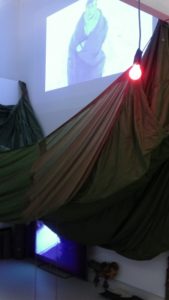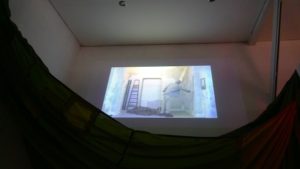Protected by a helmet and hidden in a reflected and projected image within the makeshift debris and detritus structures, I slurp at an image of myself, attempting to become whole again by drinking myself. This is in reference to Narcissus the Greek god that fell in love with his own image without recognising it, my action coming after Patty Chang’s Fountain (1999).
The larger work draws attention to how national cultural policy planners working to polarise communities in conservative revolutions, do not share responsibilities for what may be the unintended consequences for the biosphere or people who follow their advice. The work does this by extending and updating one of the throughlines of Burnt Stars (2015), nesting it in a way to explore the way that artists continue to show critical responses to resist and disable the spaces these planners attempt to set.
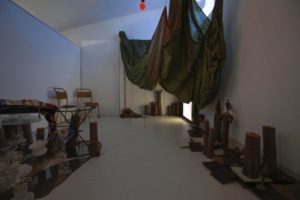 German philosopher Martin Heidegger’s work has a peculiar intellectual partnership between the German radical right of the 1920s and the post 1968 generation(1), which I continue to assert still provides fertile ground for this same post-1968 generation now in America, and by association, Australia too.(2)
German philosopher Martin Heidegger’s work has a peculiar intellectual partnership between the German radical right of the 1920s and the post 1968 generation(1), which I continue to assert still provides fertile ground for this same post-1968 generation now in America, and by association, Australia too.(2)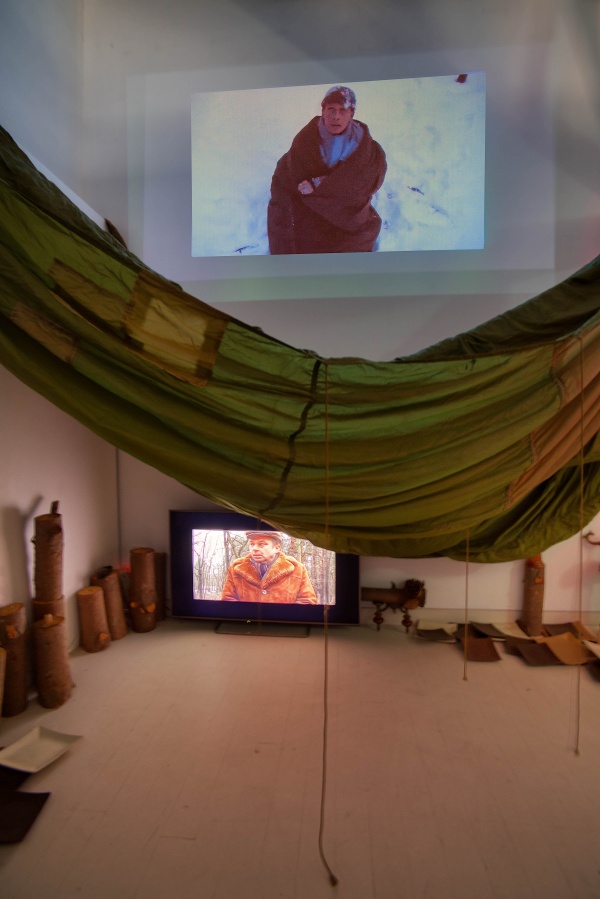 Burnt Stars was made as part of a DAAD scholarship in 2012 that extends German artist Joseph Beuys’ fictional landing rescue by the Tartars to include a crash-landing onto Heidegger’s hut. Slow Hope screens Beuys’ landing above his fallen parachute that provides architectural elements for Heidegger’s world projected on the wall below. Dealing with bell-ringing in his ears, Heidegger responds to Beuys’ crash from within his forest hut room and bunker; as well as figuratively, in his Marburg university academic office where he explains away his Nazism in the essay he is typing, The Question Concerning Technology(2). The event can be understood as catalysing Beuys’ determination to set about on a lifelong journey to use the art field to reinvigorate a socialist trajectory, by challenging and ‘crashing down on’ what both he and Germany lost to Heideggerian informed Nazism. Beuys’ journey of redemption embraced the importance of linking German political thinker Hannah Arendt’s revolutionary horizon as part of action for the common good, a position of being-in-the-world highlighted through contrast in Burnt Stars.
Burnt Stars was made as part of a DAAD scholarship in 2012 that extends German artist Joseph Beuys’ fictional landing rescue by the Tartars to include a crash-landing onto Heidegger’s hut. Slow Hope screens Beuys’ landing above his fallen parachute that provides architectural elements for Heidegger’s world projected on the wall below. Dealing with bell-ringing in his ears, Heidegger responds to Beuys’ crash from within his forest hut room and bunker; as well as figuratively, in his Marburg university academic office where he explains away his Nazism in the essay he is typing, The Question Concerning Technology(2). The event can be understood as catalysing Beuys’ determination to set about on a lifelong journey to use the art field to reinvigorate a socialist trajectory, by challenging and ‘crashing down on’ what both he and Germany lost to Heideggerian informed Nazism. Beuys’ journey of redemption embraced the importance of linking German political thinker Hannah Arendt’s revolutionary horizon as part of action for the common good, a position of being-in-the-world highlighted through contrast in Burnt Stars.
 The low-hanging bulb in Burnt Stars now shines from high above, down into a trail of logs that could have been freshly chopped by Heidegger. However, under the khaki parachute, those logs placed horizontally in an army camouflage patterned shopping bag and stockpiled nearby, appear ready for use as bombs or mines, connecting Heidegger’s activities to the war machine. A mud-cracked carpet of brown and cream square ceramic plates with upturned corners is tinged under the glow of the red-blood bulb, providing a link to war through the nationalist slogan Blut und Boden (Blood and Soil), as well as its direct contribution to the destruction of lands and desiccation of them through climate collapse; and more specifically to this location, the way Chernobyl’s weapons production disaster rendered the Schwarzvald (Black Forest) trees needleless.
The low-hanging bulb in Burnt Stars now shines from high above, down into a trail of logs that could have been freshly chopped by Heidegger. However, under the khaki parachute, those logs placed horizontally in an army camouflage patterned shopping bag and stockpiled nearby, appear ready for use as bombs or mines, connecting Heidegger’s activities to the war machine. A mud-cracked carpet of brown and cream square ceramic plates with upturned corners is tinged under the glow of the red-blood bulb, providing a link to war through the nationalist slogan Blut und Boden (Blood and Soil), as well as its direct contribution to the destruction of lands and desiccation of them through climate collapse; and more specifically to this location, the way Chernobyl’s weapons production disaster rendered the Schwarzvald (Black Forest) trees needleless.
In The Political Ontology of Martin Heidegger, Bourdieu interprets Jünger’s solution of overcoming the antithesis between democracy and socialism through the inauguration of a new social order of a military nature founded on ‘planned labour’, where the ‘new breed of Worker’ controls technology through his superior technicism, as curing illness with illness: ‘in seeking in technology and in that pure product of technology, the Worker made one with himself through the totalitarian State, the means to overcome technology’, p. 30-35. This is like the narcissistic proposal of Trump’s former chief strategist Steve Bannon, which reproduces Algabal’s apocalyptic renewal and is the second part of Slow Hope.
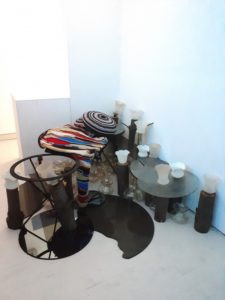 The post-1968 generation is still in power in America and is implementing Steve Bannon’s national cultural plan, which Heidegger and anti-intellectual businessman Henry Ford (1863 – 1947) were instrumental in developing. Unlike Heidegger’s appeal for dissemination using philosophy’s elite bandwidth, Bannon produced documentaries aimed straight at the general voting public. Bannon’s documentaries stake out the political terrain of Trump’s successful American presidential bid and assemble a bombastic and incoherent mash-up drawn from propaganda products in order to launch his own message, which stems from a belief that apocalyptic renewal is the solution to America’s problems.
The post-1968 generation is still in power in America and is implementing Steve Bannon’s national cultural plan, which Heidegger and anti-intellectual businessman Henry Ford (1863 – 1947) were instrumental in developing. Unlike Heidegger’s appeal for dissemination using philosophy’s elite bandwidth, Bannon produced documentaries aimed straight at the general voting public. Bannon’s documentaries stake out the political terrain of Trump’s successful American presidential bid and assemble a bombastic and incoherent mash-up drawn from propaganda products in order to launch his own message, which stems from a belief that apocalyptic renewal is the solution to America’s problems.
Protected in a helmet like the one Beuys the fighter pilot wore, and hidden in a reflected and projected image within the makeshift debris and detritus structures, I slurp at an image of myself, attempting to become whole again by drinking myself. This is in reference to Narcissus the Greek god that fell in love with his own image without recognising it, my action coming after Patty Chang’s Fountain (1999).
 However, Bannon’s portrait is inserted into my self-portrait reflection, so if I cannot resist being part of the product that he produced and circulated, and what prevails; I will become a Worker freed from ‘alienation’ (as interpreted by the Jugendbewegung meaning), freed from freedom by being alienated into becoming subsumed into the person of the Führer, Bannon himself. This notion stems from Jünger’s fantastical populism, a phantasmatic denial of marxism, that reconciles the cult of the people (Volk) with an aristocratic hatred of the ‘masses’, transfigured by mobilisation into an organic unity; where the horror of the anonymous monotony and empty uniformity is overcome, which is written all over other workers’ faces by means of that perfect realisation of empty uniformity, military mobilisation.(3)
However, Bannon’s portrait is inserted into my self-portrait reflection, so if I cannot resist being part of the product that he produced and circulated, and what prevails; I will become a Worker freed from ‘alienation’ (as interpreted by the Jugendbewegung meaning), freed from freedom by being alienated into becoming subsumed into the person of the Führer, Bannon himself. This notion stems from Jünger’s fantastical populism, a phantasmatic denial of marxism, that reconciles the cult of the people (Volk) with an aristocratic hatred of the ‘masses’, transfigured by mobilisation into an organic unity; where the horror of the anonymous monotony and empty uniformity is overcome, which is written all over other workers’ faces by means of that perfect realisation of empty uniformity, military mobilisation.(3)
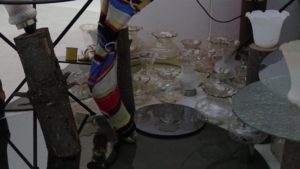 |
 |
 |
Slow Hope’s red bulb also shines down on the COIVD-19 pandemic, another unintended consequence of Bannon’s proposal, which continues to be used against people worldwide as part of it. A sea of tulip shapes frozen from their pushing and pulling swivelling dances forms the studded surface of a Covid-19 virus protein, where some sit atop raised topsy-turvy clear and smokey glass and mirrors that draw attention to our shrinking and collapsing natural systems. There is slow hope that matches for the early European-style paintings and tourist postcards we vigilantly cling to in our national psyche will continue to be found in the external world.
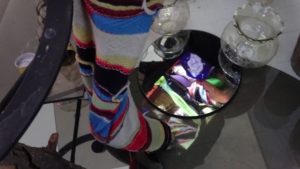 |
 |
 |
Patterned like the deranged and damaged internal tubes and organs of COVID-19 infected patients In my acid-inspired and fluoro-stitched Jenny Kee-style jumper, I am also the virus slurping randomly to latch onto cells in passageways so I can slip inside.
 |
 |
 |
The first installation grouping encountered in the gallery space comprises pine tree logs sitting upright amidst bold folkloric brass-moulded designs, most with spire-capped towers that suggest the development of old worldly European townships amidst the soft cork of others indicating woods. Together, these elements play with the way hegemonic rule attempts to block or ‘snuff out’ core organic circuitry that supports the commoning processes in the workings of communities. As a large pattern these configurations also suggest networked pathways of intellectual inquiry or the expansion of Old Europe; the latter highlighted in relation to accumulation and western Science as referenced with the part-hidden museological butterfly displays. Science here contributed a genuine curiosity in the inquiry of other cultures, contrasting starkly to the singular economic motivations of Australia’s British invasion, a market-driven thinking that lives on in all policy today.
This section of the work can be considered as a tool to imagine what foundations and structures to prioritise as part of the crumbling and rebuilding on our current path to feudalism. This is if we are to experience what American anthropologist Joseph Tainter describes as a reversible societal collapse (4). Here, the counterculture wayfinding of artists can assist.
1. In his article, ‘The Case of Martin Heidegger, Philosopher and Nazi Part 3: History, Philosophy and Mythology’ on the World Social Website, Alex Steiner maps the way in which Heidegger’s work indicates a peculiar intellectual partnership between the German radical right of the 1920s and the post-1968 generation of disappointed ex-radicals referring to American philosopher Richard Rorty’s (1931–2007) characterisation of the post-war intelligentsia in the West as the abandonment of any identification with Marxism, human- ism and Enlightenment rationality ‘ever since Marx ceased to present an alternative to Nietzsche and Heidegger.’ Richard Rorty, Essays on Heidegger and Others: Philosophical Papers Volume Two, (Cambridge University Press, Cambridge, 1991), p. 67.
2. Jenny Brown. GOVERNMENTALITY, ECONOMICS, ACTIVE CITIZENSHIP AND ART: Reparations of an allodoxic media. Thesis title for the award of Doctor of Philosophy, Sydney College for the Arts, University of Sydney, 2015.
3. In The Political Ontology of Martin Heidegger, Bourdieu states that Heidegger’s essay, ‘The Question Concerning Technology’, is in complete ideological agreement with The Worker by German soldier and author, Ernst Jünger (1895–1998), who is the intellectual spokesman for conservative revolutionaries. Jünger and Heidegger appeal to other people to assume their responsibilities by experiencing the elementary violence of the here and now, which involves taking up an extreme position to flirt with annihilation to appreciate freedom in the moment of its destruction. As part of this, they share an inability to assume responsibility for what may be the consequences for people who do follow their advice. Jüngerian nihilism set itself up as a revolt against European decadence. It aimed to substitute action for contemplation, and to give priority to the act of choosing over the end chosen, and, ultimately, to prefer the will to will over life, or in Heidegger’s expression, the will to power.
4. Joseph Tainter, in his book, The Collapse of Complex Societies (1988), explores the ways in which past complex societies have fallen and shows their relevance for the present. Tainter shows that collapse is a dynamic process that cannot be attributable to one factor alone, such as resource depletion, even though resources are an important part of the explanation. One characteristic of complex systems is that they adapt to changing external conditions through homeostasis. This concept, taken from system dynamics, entails what is known as a forcing and feedback, rather than cause and effect. A forcing is something that comes from outside the system, and feedback, both positive and negative, refers to the ways in which the system stabilises itself in reaction to a forcing, i.e. reaches homeostasis. According to Tainter’s model, there are five elements interacting in feedback relationships, although the most important of these for the world at the moment is the interaction between capital and natural resources. Homeostasis can only be maintained if resources are available for the required energy.

